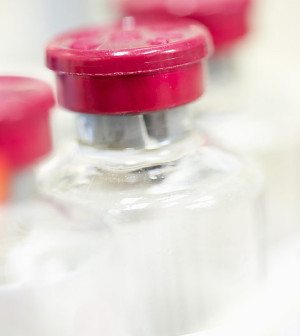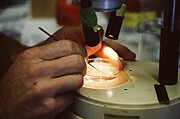- Navigating Your Midlife Crisis: Embracing New Possibilities
- City Raccoons Showing Signs of Domestication
- Mapping the Exposome: Science Broadens Focus to Environmental Disease Triggers
- One Week Less on Social Media Linked to Better Mental Health
- Your Brain Changes in Stages as You Age, Study Finds
- Some Suicide Victims Show No Typical Warning Signs, Study Finds
- ByHeart Formula Faces Lawsuits After Babies Sickened With Botulism
- Switch to Vegan Diet Could Cut Your Greenhouse Gas Emissions in Half
- Regular Bedtime Does Wonders for Blood Pressure
- Dining Alone Could Mean Worse Nutrition for Seniors
Stem Cells Yield Lab-Grown Skin, Researchers Say


Skin that was created from stem cells and grown in a lab could be used instead of animals to test drugs and cosmetics, and to develop new treatments for skin disorders, scientists report.
An international team of researchers said it’s the first to create lab-grown epidermis — the outermost layer of skin — that has a functional barrier like real skin. The functional barrier prevents water from escaping the body and keeps germs and toxins out. Until now, no one had successfully grown epidermis with a functional barrier, which is needed for drug testing, the study authors said.
The research, led by scientists at King’s College London and the San Francisco Veteran Affairs Medical Center, is described in the current issue of the journal Stem Cell Reports.
The ability to create an unlimited amount of genetically identical skin samples “can be used to study a range of conditions where the skin’s barrier is defective due to mutations in genes involved in skin barrier formation, such as ichthyosis (dry, flaky skin) or atopic dermatitis (eczema),” Dr. Theodora Mauro, leader of the research team, said in a King’s College London news release.
“We can use this model to study how the skin barrier develops normally, how the barrier is impaired in different diseases and how we can stimulate its repair and recovery,” she said.
Dr. Dusko Ilic, leader of the team at King’s College London, said: “Our new method can be used to grow much greater quantities of lab-grown human epidermal equivalents, and thus could be scaled up for commercial testing of drugs and cosmetics.”
“Human epidermal equivalents representing different types of skin could also be grown, depending on the source of the stem cells used, and could thus be tailored to study a range of skin conditions and sensitivities in different populations,” he added.
More information
The U.S. National Library of Medicine has more about skin conditions.
Source: HealthDay
Copyright © 2025 HealthDay. All rights reserved.










